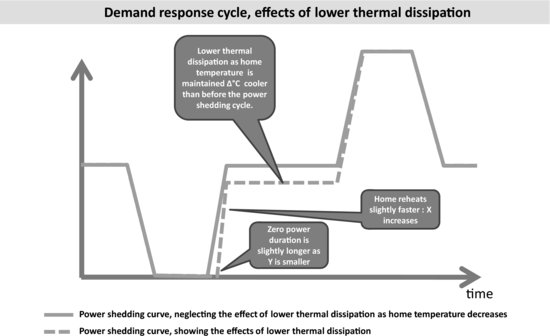Appendix D
Lower Consumption, A Side Benefit of Power Shedding
When the user accepts to live in a home slightly colder than Tref, the thermal dissipation of his home also decreases. The thermal dissipation of the home was K × (Tref – Text) and becomes K × (Tref – Text – Δ).
The effect of this lower thermal dissipation is to slightly increase X as the temperature decreases, and to slightly decrease Y (Figure D.1). These effects have been ignored in the evaluations of Appendices B and C.
Figure D.1 Effects of the lower thermal dissipation on the power shedding cycle.

However, the overall power savings resulting from the lower thermal dissipation during power shedding are easy to evaluate, in a simplified model where we ignore the heating hysteresis H:
- When the temperature is stabilized to Tref – Δ, the energy used to reheat the houses can be expressed as P′ =
 : if
: if  and Δ = 1 °C, P is 10% lower than P′.
and Δ = 1 °C, P is 10% lower than P′. - During the temperature decrease period, the dissipation power decreases quasilinearly (we approximate the exponential evolution of the home temperature by a linear function) from Pn to P′. If C is the thermal capacity of the house, k the thermal dissipation, t the duration of the house ...

